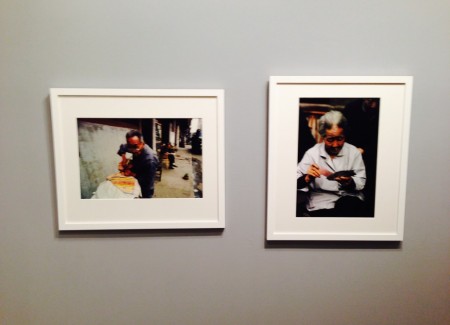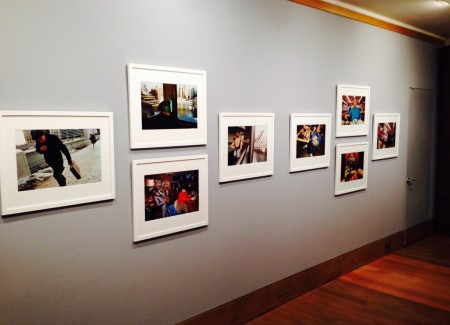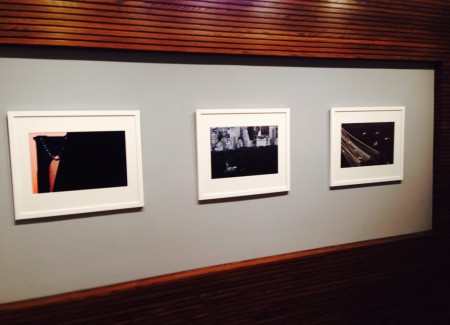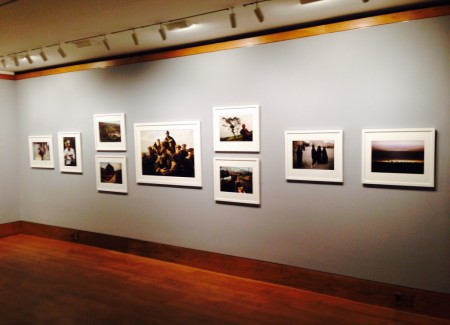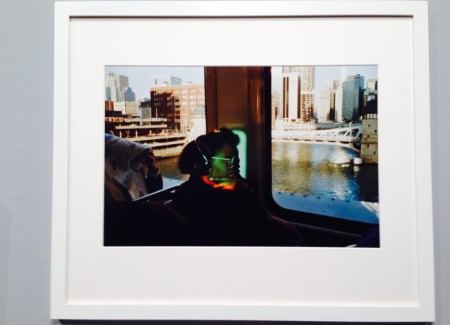JTF (just the facts): A total of 28 color photographs, framed in white and matted, and hung against grey walls in the main gallery space. All of the works are archival pigment prints, from images made between 1957 and 2004. Each of the prints is sized 16×20 (or reverse) and is available in an edition of 15. The exhibition is a selection from the book of the same name, published in 2104 by Steidl (here), with an afterword by the artist. (Installation shots below.)
Comments/Context: What does it say about Bruce Davidson that his finest efforts in color have the same subject, namely public transportation? Were he and his camera most alert and synchronized with their surroundings back in the mid-‘80s, while riding in dingy subways and sun-dappled buses around America’s big cities with no particular place to go?
It appears so, judging from the samples in this small and disappointing show.
One outstanding image here, from 1989, is almost as good as the ones in his classic 1986 Aperture book Subway. It’s a portrait of a woman on the Chicago El, her face tinged by an eerie green and orange light as she listens to an unheard-something through her head phones. (Even better is a dual Chicago portrait in the Steidl book of a woman in a red dress seated in the back of a bus behind another passenger reading a book, both of them too well-dressed—one is wearing pearls—to be going to work; more likely they are on their way to church.)
These Chicago portraits were done spontaneously, the women given the freedom to have an interior life that Davidson is not privy to. More often than not, he poses people, with predictable results. For decades he has been a photojournalist for Magnum, hired by Vogue, Life, National Geographic, Travel & Leisure and other picture magazines to put a smiling, humanist, American face on the world.
The non-controversial subjects in this show include Welsh coal miners and their families; tourists on Martha’s Vineyard and along the Pacific Coast Highway; a line of covered up Iranian women; a barber on the street in China; and outdoor scenes of bridges in Chicago and New York. Missing from all of these photographs is the intensity and grit for which Davidson was initially recognized. His 1960s series in black-and-white from East Harlem documented both the fragile lives of the residents and his identification with them. The images here, especially those from the 1960s and ‘70s, could have been made by a dozen other photographers. They’re like stock versions of these places and they illustrate why color photography had such a poor reputation among artists.
The exception to these generic postcards—the worst depict Central Park and New York harbor—are a grotesque series from 2004 of people feasting at Katz’s deli on the Lower East Side of Manhattan. The zany compositions in the four examples here (an assignment from Esquire) are packed with energy and information. Davidson risked upsetting his subjects (and viewers) by employing a wide-angle lens, flash, and extreme close-ups. There are middle-aged men, one with his cheeks stuffed and yet only getting started on the meal spread out on the table in front of him; another face (identified only by his maw and bushy gray mustache) is ready to chomp down on a mustard-beribboned stack of corned beef. The middle-aged women are equally hungry. One of them secures an infant with one hand and with the other drops a piece of pastrami into her mouth (the cover shot of the book). Daintiness is out of the question at Katz’s, which doesn’t stop one customer from gamely trying to hold a juicy sandwich lightly enough to keep her nails dry.
Unlike his color elsewhere, Davidson use of it here is exciting—the pinks of the human tongues match the pinks of the smoked meats—and integral to the raunchy humor of the pictures. These are satisfied customers—anyone who isn’t a vegetarian would want to have what they’re having—and he captures the relationship between sex and food without being pornographic.
One might object that Martin Parr and Lee Friedlander did extreme pictures of eating and drinking first, or that pastrami shouldn’t ever be better-looking than the people consuming it. But given the bland fare Davidson is serving in the rest of this miniature retrospective, any spice is welcome.
“Although I never ordered this greasy meat myself, I felt a strong connection between the idea of peace in the world and a plate of hot pastrami,” Davidson writes in the afterword in words that are also appropriate at this time of year. “In a world of indiscriminate violence, gross gentrification, and a loss of cultural identity, a bite of pastrami may put us at ease with our neighbors and ourselves.”
Collector’s POV: All prints are non-vintage and priced at $6500. Davidson’s work has only been intermittently available in the secondary markets in the past few years, with very few of his best vintage images coming up for sale. Recent prices for those prints that have sold have ranged between $1000 and $15000.

